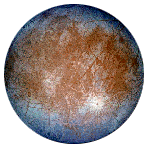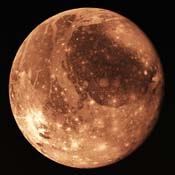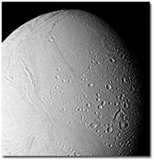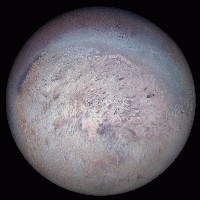Europa

Image taken from http://www.mufor.org/
|
Europa is a moon of Jupiter, but unlike
Io, it is covered with a smooth layer of ice. It does experience tidal
heating, which allows for a layer of water beneath the ice. Europa displays
cryovolcanism, where water replaces magma as the substance being erupted.
They cryovolcanism explains the smoothness of the surface.
|
Ganymede

Image taken from http://www.planetary.org/html/news/articlearchive/headlines/2001/ganymede.html
|
Ganymede shows both old, dark surface
and young, light surface. It has a variety of grooves, fractures, and
grabens indicating tectonism. Ganymede as well as Europa may experience
cryovolcanism.
|
Enceladus

Image taken from http://saturn.jpl.nasa.gov/news/saturn-story/moons.cfm
|
Saturn's moon Enceladus has a very smooth,
fresh surface. It is an icy satellite, and displays cryovolcanism. It
has very new ridges and plains, probably caused by ice flows or an explosion
of ice particles. It is still active currently.
|
Triton

Image taken from http://www.astrosurf.com/lombry/sysol-kbo.htm
|
Triton is an ice covered moon of Neptune.
It's surface is relatively smooth, indicating cryovolcanism. The
surface of Triton is riddled with cryovolcanic geysers that throw plumes of
ice into the atmosphere. The geysers may be solar driven despite the
fact that Triton is so far from the sun and is so cold.
|



